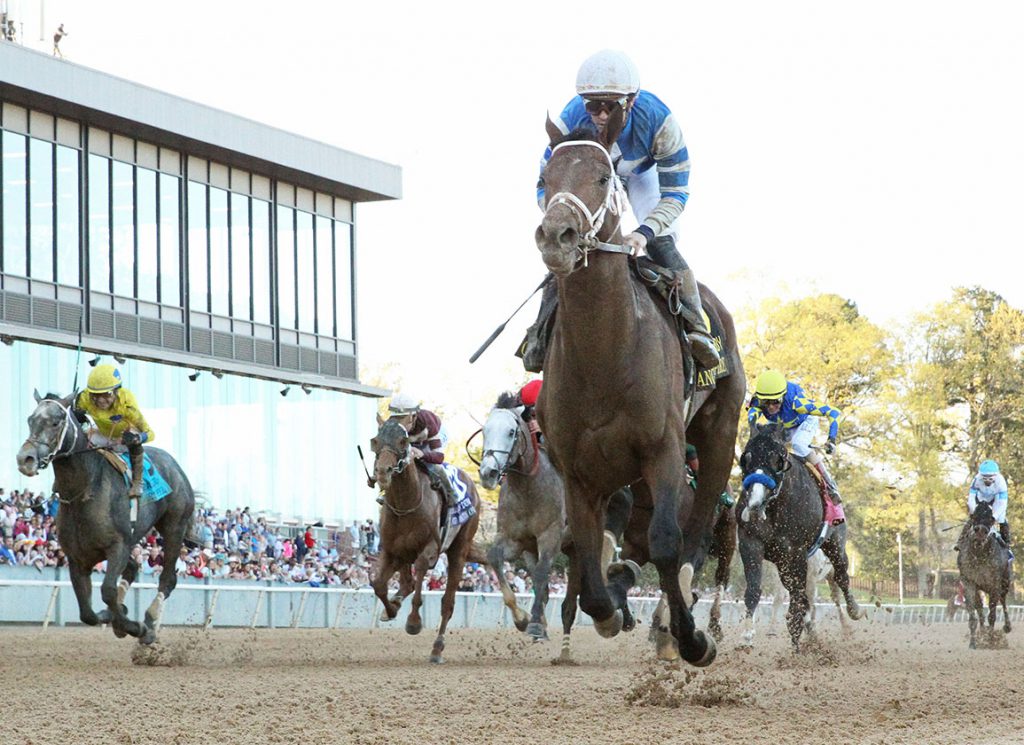An unintended consequence of moving all of the final, 100-point, nine-furlong preps for the GI Kentucky Derby to four weeks out is that there is now nearly a full month without any meaningful (to the general public) action in the lead-up to America’s most historic and important horse race.
When viewed alongside other professional sports, which have significantly expanded their playoff structures in recent seasons to capitalize on the immediacy (and bettability) of wild-card and play-in games with last-chance qualifying berths on the line, the lead-up to the Derby has gone in the opposite direction, minimizing the relevancy of making the final cut as the main event looms closer.
Although four-week spacing is in line with the current less-is-more approach to training top-level sophomores, it’s difficult to believe that trend is so etched in stone that it necessitates stacking up the final, most lucrative preps so that three races with the exact same conditions at the exact same distance-the GI Blue Grass S., the GI Santa Anita Derby, and the GII Wood Memorial S.-all must go off within an hour of each other four weeks prior to the first Saturday in May.
No disrespect to ‘TDN Rising Star‘ Disarm (Gun Runner), but the six points he accrued by running third in this past Saturday’s GIII Lexington S. at Keeneland didn’t exactly make for must-watch racing. It elevated him from 26th to 18th on the qualifying list and dislodged one other competitor, fellow ‘Rising Star’ Jace’s Road (Quality Road).
The Lexington S. is more of a last-gasp shot at the tail end of the “Road to the Kentucky Derby” points series with only 20 total points up for grabs, and its 1 1/16-miles distance is a cutback compared to the stakes that precede it.
If the Derby is going to have a qualifying points system, why not accentuate the inherent drama of racking up points when they are most coveted? If one of those final three 100-points, 1 1/8-miles stakes were to get boldly repositioned to three weeks out, would horses not come?
I think they would-and there would be additional advantages to the track that tries it from the perspective of having a marquee day of racing without much competition.
As recently as 2021, Oaklawn Park was the “only game in town” three Saturdays before the Derby, with its premier stakes, the GI Arkansas Derby, the focal point on the national calendar.
Over the previous decade, that three-week template worked pretty well. It was the springboard for American Pharoah‘s Triple Crown campaign in 2015, plus the Arkansas Derby also produced the 2012 Kentucky Derby favorite, Bodemeister (who ran second in Louisville), and the 2019 Kentucky Derby morning-line favorite, Omaha Beach, who had to scratch days before the race with an entrapped epiglottis.
But in 2022, Oaklawn readjusted its series of prep races by moving back the date of the Arkansas Derby so it sat five weeks out. A pre-Kentucky Derby void now exists that generates little meaningful news or excitement, and the kicker is that this past weekend is also a traditionally slow one on the mid-April national sports landscape.
No, this is not an unrealistic plea to roll back the clock four decades to the era when Churchill Downs used to card the Derby Trial S. on the Tuesday (four days!) before the Derby itself, where it served as a legitimate prep opportunity.
But it’s interesting to see how the timetable has evolved for the spacing of the spring’s big 3-year-old stakes at Keeneland, Santa Anita and Aqueduct.
The Blue Grass was last run three weeks before the Derby in 2014, having occupied that spot on the calendar for 26 years. As recently as 1988, it was carded 10 days before the Derby.
The Santa Anita Derby has maintained four-week spacing prior to the Kentucky Derby since 1981, when it ran 20 days before the Derby. In 1980 and in some years in the 1970s, a late-March placement five weeks out was the norm.
The last time the Wood Memorial ran three weeks out from the Derby was in 2004. It had been that way since 1993, when two weeks out was the standard.
Of those three races, the Wood Memorial could be best positioned to make a move back to three weeks out. The New York Racing Association (NYRA) has been innovative about readjusting other aspects of its stakes schedule in recent years. And-let’s face it-as the lone Grade II race among that trio, it has more incentive to distinguish itself in an effort to regain the Grade I status that the American Graded Stakes Committee stripped away after the 2016 edition.
Had the Wood (and its same-day supporting stakes) been carded for Apr. 15 this year, it wouldn’t have had to contend with the opening Saturday of the Keeneland meet, and it would have simultaneously sidestepped the biggest day of the Santa Anita season. In addition, all of racing on that Apr. 8 weekend had to go up against the immensely popular Masters golf tournament, which since the advent of legalized sports wagering in the United States has intensified the competition for viewing eyeballs and betting dollars.
There’s another upstream advantage to making the switch as well: When Oaklawn retooled its Derby prep schedule, it also left a vacancy in the national schedule for the third week of March, which had previously been occupied by the GII Rebel S.
This year and last season there were no points-awarding “Road to the Derby” stakes in the two weeks between the GIII Tampa Bay Derby and the GII Louisiana Derby. If NYRA were to retrofit the Wood to three weeks before the Kentucky Derby, it could also move the GIII Gotham S. off its similarly crowded first-Saturday-in March slot, giving it solo status in mid-March while also putting the race in a spot where it isn’t as endangered by the threat of winter weather.
Despite their shifting placements on the calendar, the last Wood Memorial winner to score in the Derby was Fusaichi Pegasus in 2000, and the last Blue Grass winner to wear a blanket of roses in Louisville was Strike the Gold in 1991. The Santa Anita Derby has been more recently productive, with its winners scoring in the Kentucky Derby in 2018, 2014 and 2012.
Maybe it will take Disarm winning the Derby this year off a three-week prep to nudge some track to claim that potentially lucrative piece of prime-time real estate.
The post The Week In Review: Prime-Time Real Estate Remains Vacant On Derby Prep Calendar appeared first on TDN | Thoroughbred Daily News | Horse Racing News, Results and Video | Thoroughbred Breeding and Auctions.







